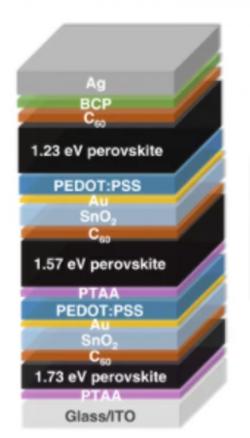Researchers led by Eindhoven University of Technology in the Netherlands have developed a process that allowed them to fabricate three perovskite layers, and combined these layers into a device that reached 16.8% conversion efficiency.

While tandem cells are the focus of intensive research, combining several active layers into one cell is less explored. Efficiencies close to the 40% mark have been achieved with III-V materials, but for all perovskite devices, the efficiency record previously stood at 6.7%.
A tandem cell comprising the wide and narrow perovskites achieved 19.5% efficiency. In the triple-junction cell, efficiency is limited by the current of the narrow bandgap layer and parasitic absorption from the electrodes.
It is in the wide bandgap perovskite, however, that the researchers identify a need for improvement. 'â¦further improving the PCE of all-perovskite triple-junction solar cells would require an efficient ~2'eV wide bandgap perovskite, which enables a more balanced light absorption in each absorber layer,' the researchers said. 'However, such wide bandgap PSCs with low open circuit voltage deficit has not been reported to date.'
The group notes that, though there is a need for more work to tackle this limitation, its approach presents a reproducible method to produce multiple perovskite layers using a single process.